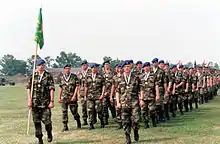Theater (warfare)
In warfare, a theater or theatre (see spelling differences) is an area in which important military events occur or are progressing.[1][2] A theater can include the entirety of the airspace, land and sea area that is or that may potentially become involved in war operations.[3]
| Part of a series on |
| War |
|---|
| Military organization | ||||||||||||||||||||||||||||||||||||
|---|---|---|---|---|---|---|---|---|---|---|---|---|---|---|---|---|---|---|---|---|---|---|---|---|---|---|---|---|---|---|---|---|---|---|---|---|
 | ||||||||||||||||||||||||||||||||||||
|
||||||||||||||||||||||||||||||||||||
Theater of war
In his book On War, Carl von Clausewitz defines the term Kriegstheater (translating the older, 17th-century Latin term theatrum belli) as one that:
"Denotes properly such a portion of the space over which war prevails as has its boundaries protected, and thus possesses a kind of independence. This protection may consist of fortresses, or important natural obstacles presented by the country, or even in its being separated by a considerable distance from the rest of the space embraced in the war. Such a portion is not a mere piece of the whole, but a small whole complete in itself; and consequently it is more or less in such a condition that changes which take place at other points in the seat of war have only an indirect and no direct influence upon it. To give an adequate idea of this, we may suppose that on this portion an advance is made, whilst in another quarter a retreat is taking place, or that upon the one an army is acting defensively, whilst an offensive is being carried on upon the other. Such a clearly defined idea as this is not capable of universal application; it is here used merely to indicate the line of distinction."[4]
Theater of operations
Theater of operations (TO) is a sub-area within a theater of war. The boundary of a TO is defined by the commander who is orchestrating or providing support for specific combat operations within the TO.
Theater of operations is divided into strategic directions or military regions depending on whether it is a war or peacetime. The United States Armed Forces split into Unified Combatant Commands (regions) that are assigned to a particular theater of military operations. A strategic direction is a group of armies also known as a task (field) forces or battlegroups.
A strategic command or direction in general essence would combine a number of tactical military formations or operational command. In the modern military, a strategic command is better known as a combat command that may be a combination of groups.
Soviet and Russian Armed Forces
The Soviet and Russian Armed Forces classify a large geographic subdivision—such as continental geographic territories with their bordering maritime areas, islands, adjacent coasts[5] and airspace—as a theater. The Russian-language term for a military "theater" is театр военных действий, teatr voennykh deistvii (literally: "theater of military operations"), abbreviated ТВД, TVD.
The division of large continental and maritime areas assists in determining the limits within which to develop plans for the operations of strategic military groups of forces, allowing military operations of specific significant "strategic directions" known as "fronts", which were originally named in accordance with their theater of operations; for example the Southwestern Front (Russian Empire) (1914–1918), the 1st Ukrainian Front (1943–1945, which fought in Ukraine, Poland, Germany, and Czechoslovakia), and the Northern Front (Soviet Union) (June to August 1941). In peacetime, lacking the urgencies of a strategic direction, fronts were transformed into military regions (districts) responsible for an assigned section of operations.
United States


The term "theater of operations" was defined in the American field manuals as the land and sea areas to be invaded or defended, including areas necessary for administrative activities incident to the military operations (chart 12). In accordance with the experience of World War I, it was usually conceived of as a large land mass over which continuous operations would take place and was divided into two chief areas—the combat zone, or the area of active fighting, and the communications zone, or area required for administration of the theater. As the armies advanced, both these zones and the areas into which they were divided would shift forward to new geographic areas of control.[6]
See also
References
- "Definition of theatre noun (MILITARY) from Cambridge Dictionary Online: Free English Dictionary and Thesaurus". Dictionary.cambridge.org. Retrieved 2011-08-31.
- "Theater (warfare) – definition of Theater (warfare) by the Free Online Dictionary, Thesaurus and Encyclopedia". Thefreedictionary.com. Retrieved 2011-08-31.
- "theatre of war, theatres of war- WordWeb dictionary definition". www.wordwebonline.com.
- Carl von Clausewitz (1956). On War. Jazzybee Verlag. p. 162. Retrieved 2020-05-16.
- See: Voennyj entsiklopedicheskij slovarj (BES) Военный энциклопедический словарь (ВЭС) [Military encyclopedic dictionary] (in Russian). Moscow: Военное издательство (ВИ). 1984. p. 732.
- "Chapter VII: Prewar Army Doctrine for Theater". History.amedd.army.mil. Retrieved 2011-08-31.